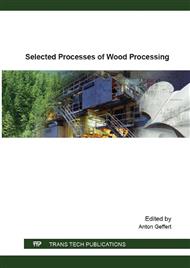[1]
I.G. Goldstein, Degradation of Wood by Chemicals, in: R. Rowell (Ed. ), The chemistry of solid wood, Advances in Chemistry Series No. 207, American Chemical Society, Washington, 1984, pp.577-588.
Google Scholar
[2]
R.A. Eaton, M.D.C. Hale, Wood: Decay, Pests, and Protection, first ed., Chapman & Hall, London, (1993).
Google Scholar
[3]
J.E. Winandy, Effects of fire retardant treatments after 18 months of exposure at 150 °F (66 °C), USDA Forest Serv., Forest Prod. Lab. Research Note FPL-RN-0264. (1995).
Google Scholar
[4]
A. Unger, A. Schniewind, W. Unger, Conservation of Wood Artifacts: A Handbook, first ed., Springer-Verlag, Berlin Heidelberg, (2001).
Google Scholar
[5]
J.A. Emery, H.A. Schroeder, Iron-Catalyzed Oxidation of Wood Carbohydrates, Wood Sci Technol. 8 (1974) 123-137.
DOI: 10.1007/bf00351367
Google Scholar
[6]
S.L. LeVan, J.M. Kim, R.J. Nagel, J.W. Evans, Mechanical properties of fire-retardant-treated plywood after cyclic temperature exposure, Forest Products J. 46 (1996) 64-71.
Google Scholar
[7]
K.K. Pandey, Reaction of wood with inorganic salts, Holz Roh Werkst. 56 (1998) 412-415.
DOI: 10.1007/s001070050343
Google Scholar
[8]
S.N. Kartal, W.J. Hwang, Y. Imamura, Combined effect of boron compounds and heat treatments on wood properties: Chemical and strength properties of wood, J Mater Process Technol. 198 (2008) 234-240.
DOI: 10.1016/j.jmatprotec.2007.07.001
Google Scholar
[9]
D. Fengel, G. Wegener, Wood: Chemistry, Ultrastructure, Reactions, first ed., Walter de Gruyter, Berlin and New York, (1984).
DOI: 10.1163/22941932-90000910
Google Scholar
[10]
TAPPI T 257 cm-85: Sampling and preparing wood for analysis. (2001).
Google Scholar
[11]
TAPPI T 204 om-88: Solvent extractives of wood and pulp. (2001).
Google Scholar
[12]
S.O. Prozil, Caracterização química do engaço da uva e possiveis aplicaçöes, Universidade de Aveiro, Diploma thesis. (2008).
Google Scholar
[13]
K. Seifert, Zur Frage der Cellulose-Schnellbestimmung nach der Acetylacetone-Methode, Das Papier. 14 (1960) 104-106.
Google Scholar
[14]
TAPPI T 222 om-88: Acid-insoluble lignin in wood and pulp. (1988).
Google Scholar
[15]
TAPPI T 211 om-93: Ash in wood, pulp, paper and paperboard: combustion at 525 °C. (2000).
Google Scholar
[16]
R. Solár, Chémia dreva, second ed., Technická univerzita vo Zvolene, Zvolen, (2004).
Google Scholar
[17]
V. Bukovský, Degradačné reakcie celulózy a lignínu v procese prirodzeného a urýchleného starnutia papiera, first ed., Slovenská národná knižnica, Martin, (2004).
Google Scholar
[18]
S.L. LeVan, R.J. Ross, J.E. Winandy, Effects of fire retardant chemicals on the bending properties of wood at elevated temperatures, Forest Prod. Lab. Research paper FLD-RP-498. (1990).
Google Scholar
[19]
N. Ayrilmis, Effect of fire retardants on internal bond strength and bond durability of structural fiberboard, Build Environ. 42 (2007) 1200-1206.
DOI: 10.1016/j.buildenv.2005.11.017
Google Scholar
[20]
D.A. Hodgin, A.W.C. Lee, Comparison of strength properties and failure characteristics between fire-retardant-treated and untreated roofing lumber after long-term exposure: a South Carolina case study, For Prod J. 52 (2002) 91-94.
Google Scholar
[21]
E. Sjöström, Wood chemistry: fundamentals and applications, second ed., Academic Press, New York, (1981).
Google Scholar
[22]
M. Funaoka, T. Kako, I. Abe, Condensation of lignin during heating of wood, Wood Sci Technol. 24 (1990) 277-288.
DOI: 10.1007/bf01153560
Google Scholar
[23]
M.S. Sweet, J.E. Winandy, Influence of degree of polymerization of cellulose and hemicellulose on strength loss in fire-retardant-treated southern pine, Holzforschung. 53 (1999) 311-317.
DOI: 10.1515/hf.1999.051
Google Scholar
[24]
F.E. Brauns, The chemistry of lignin, first ed., Academic Press, New York, (1952).
Google Scholar
[25]
A. Blažej, M. Košík, Fytomasa ako chemická surovina, first ed., Veda, Bratislava, (1985).
Google Scholar
[26]
W.E. Hillis, Distribution, properties and formation of some wood extractives, Wood Sci Technol. 5 (1971) 272-289.
DOI: 10.1007/bf00365060
Google Scholar
[27]
R.C. Pettersen, The Chemical Composition of Wood, in: R.M. Rowell (Ed. ), The Chemistry of solid wood, ACS Advances in Chemistry Series No. 207, American Chemical Society, Washington D.C., 1984, pp.57-126.
DOI: 10.1021/ba-1984-0207.ch002
Google Scholar


